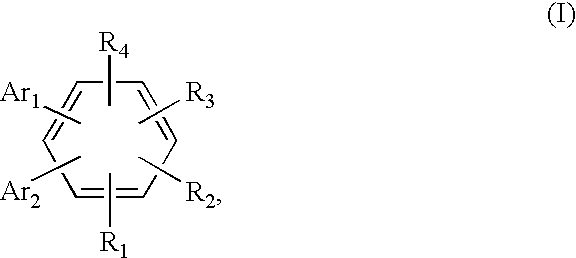Fused polynuclear compound and organic luminescence device
a technology of luminescence device and polynuclear compound, which is applied in the direction of discharge tube luminescence screen, other domestic articles, etc., can solve the problems of insufficient color purities, change of luminance, and accompanied luminescence device durability
- Summary
- Abstract
- Description
- Claims
- Application Information
AI Technical Summary
Benefits of technology
Problems solved by technology
Method used
Image
Examples
synthesis example 2
(Synthesis of Ex. Comp. No. 64)) ##STR36##
In a 500 ml-three necked flask, 0.8 g (2.52 mM) of 1,3,5-tribromobenzene[1], 4.8 g (12.6 mM) of fluorene-based boric acid [3], 160 ml of toluene and 80 ml of ethanol were placed and stirred in a nitrogen atmosphere at room temperature.
To the mixture, an aqueous solution of 15 g of sodium carbonate in 75 g of water was added dropwise and then 0.44 g (0.378 mM) of tetrakis (triphenylphosphine)palladium (0) was added. The system was stirred for 30 minutes at room temperature and heated up to 77.degree. C., followed by stirring for 3 hours.
After the reaction, the reaction mixture was subjected to extraction of the organic layer with chloroform and dried with anhydrous sodium sulfate, followed by purification by silica gel column chromatography (eluent: hexane / toluene) to obtain 2.00 g of an objective compound (Ex. Comp. No. 64) (white crystal: Yield: 73%).
synthesis example 3
(Synthesis of Ex. Comp. No. 65)) ##STR37##
In a 500 ml-three necked flask, 0.75 g (1.88 mM) of 1,2,4,5-tetrabromobenzene [4], 3.0 g (12.6 mM) of fluorene-based boric acid [2], 160 ml of toluene and 80 ml of ethanol were placed and stirred in a nitrogen atmosphere at room temperature.
To the mixture, an aqueous solution of 15 g of sodium carbonate in 75 g of water was added dropwise and then 0.43 g (0.376 mM) of tetrakis (triphenylphosphine)palladium (0) was added. The system was stirred for 30 minutes at room temperature and heated up to 77.degree. C., followed by stirring for 5 hours.
After the reaction, the reaction mixture was subjected to extraction of the organic layer with chloroform and dried with anhydrous sodium sulfate, followed by purification by silica gel column chromatography (eluent: hexane / toluene) to obtain 1.41 g of an objective compound (Ex. Comp. No. 65) (white crystal: Yield: 88%).
synthesis example 4
(Synthesis of Ex. Comp. No. 66)) ##STR38##
In a 500 ml-three necked flask, 0.75 g (2.52 mM) of 1,2,4,5-tetrabromobenzene [4], 4.8 g (12.6 mM) of fluorene-based boric acid [3], 160 ml of toluene and 80 ml of ethanol were placed and stirred in a nitrogen atmosphere at room temperature.
To the mixture, an aqueous solution of 15 g of sodium carbonate in 75 g of water was added dropwise and then 0.43 g (0.376 mM) of tetrakis (triphenylphosphine)palladium (0) was added. The system was stirred for 30 minutes at room temperature and heated up to 77.degree. C., followed by stirring for 5 hours.
After the reaction, the reaction mixture was subjected to extraction of the organic layer with chloroform and dried with anhydrous sodium sulfate, followed by purification by silica gel column chromatography (eluent: hexane / toluene) to obtain 1.88 g of an objective compound (Ex. Comp. No. 66) (white crystal: Yield: 70%).
PUM
| Property | Measurement | Unit |
|---|---|---|
| thickness | aaaaa | aaaaa |
| thickness | aaaaa | aaaaa |
| temperature | aaaaa | aaaaa |
Abstract
Description
Claims
Application Information
 Login to View More
Login to View More - R&D
- Intellectual Property
- Life Sciences
- Materials
- Tech Scout
- Unparalleled Data Quality
- Higher Quality Content
- 60% Fewer Hallucinations
Browse by: Latest US Patents, China's latest patents, Technical Efficacy Thesaurus, Application Domain, Technology Topic, Popular Technical Reports.
© 2025 PatSnap. All rights reserved.Legal|Privacy policy|Modern Slavery Act Transparency Statement|Sitemap|About US| Contact US: help@patsnap.com



